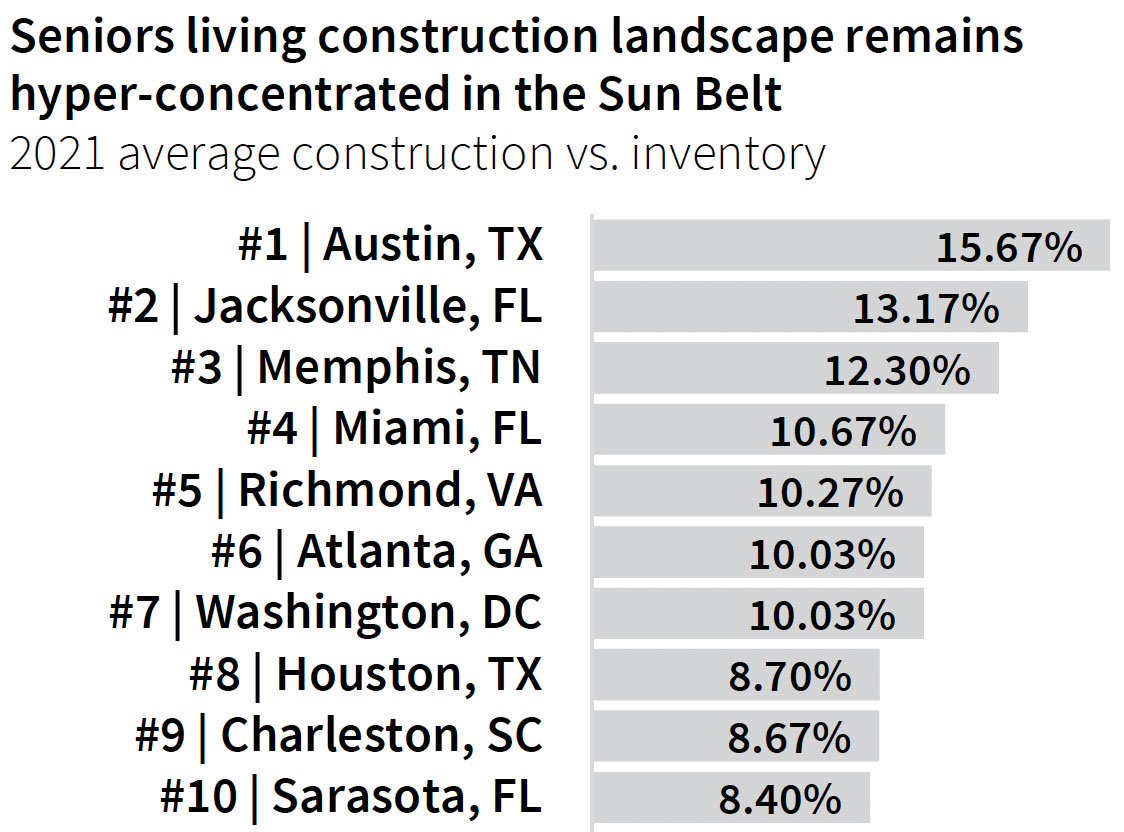CHICAGO — Backed by strong long-term demand and increased investor interest, the seniors housing sector is now fully in recovery mode, according to JLL’s Valuation Advisory group’s fifth annual Seniors Housing Investor Survey and Outlook. The survey also revealed that investors are bullish on the seniors housing and care sector as a result of the projected “silver tsunami” of retired baby boomers and expected subsequent supply shortage.
The survey had more than 100 respondents, all transactional professionals who specialize in the seniors housing and care space. The Chicago-based firm released the report on March 31.
Of the investors surveyed, 80 percent indicated they believe the worst of the pandemic has passed and expect market fundamentals to continue to improve, a significant increase over responses from last year’s survey when only 48 percent of investors expressed that sentiment. Additionally, 76 percent of respondents expect to increase their exposure to seniors housing over the next year, demonstrating a healthy market outlook for 2022 and beyond.
“We have witnessed the market stabilizing as the fundamentals have continued to improve over the last few quarters,” says Brian Chandler, JLL managing director and co-lead for the seniors housing valuation advisory practice. “Occupancy rates in several markets are beginning to get back to pre-pandemic levels. In addition, the pace of rent growth accelerated throughout 2021 and is expected to continue throughout the year.”
Transaction volumes rebounded in the fourth quarter of 2021, with an increase of 61 percent over the first quarter and rising to levels last seen at the end of 2019. Even the most operationally challenged segment — skilled nursing — rallied with a 24 percent year-over-year increase.
At year-end 2021, the average seniors housing price per unit was just under $160,000, up 9 percent from its previous trough in the first quarter of 2021 but still below the pre-pandemic peak of roughly $180,000 per unit.
For 2022, investor activity for seniors housing is expected to continue at a pace higher than 2021 due to plenty of capital/liquidity in the market, REITs continuing to sell their secondary-market product and more core funds entering the space.
As investors search for yield in an ultra-competitive landscape, some are turning to alternative asset classes like seniors housing for growth. In a change from the last survey, when participants reported focusing on more traditional and need-driven segments, the active adult segment has emerged as the most sought-after investment opportunity over assisted living.
“We are seeing demand improve each quarter, so the long-term opportunity is quite attractive for institutional capital looking to diversify their portfolios or hedge against riskier investment classes,” says Bryan Lockard, JLL managing director and co-lead for the seniors housing valuation advisory practice. “Additionally, capital for commercial real estate investment continues to accelerate to all-time highs, reaching $243.7 billion in February 2022.”
The over-80 population mainly drives the current demand for seniors housing product. However, at the start of 2022, the industry began a new 10-year investment cycle that will include a large population of baby boomers either moving into or planning a move into a retirement community.
This influx of new residents entering seniors housing is expected to create a supply shortage, magnifying demand. JLL projects that the sector will be undersupplied by 600,000 units by 2045, suggesting the supply growth must increase by more than 25,000 per year to meet peak demand levels.
Construction activity has increased in primary markets after previously tapering off due to obstacles related to the COVID-19 pandemic, whereas secondary market locations are still lagging.
“Seniors are seeking more affordable, yet still dynamic, communities in which to retire, and this has prompted developers to follow suit,” says Chandler. “Current construction activity is highly concentrated in Sun Belt markets, reflecting an acceleration in migration patterns among all age groups, but especially those in the 55-plus cohort.”
To view the full report, click here.

